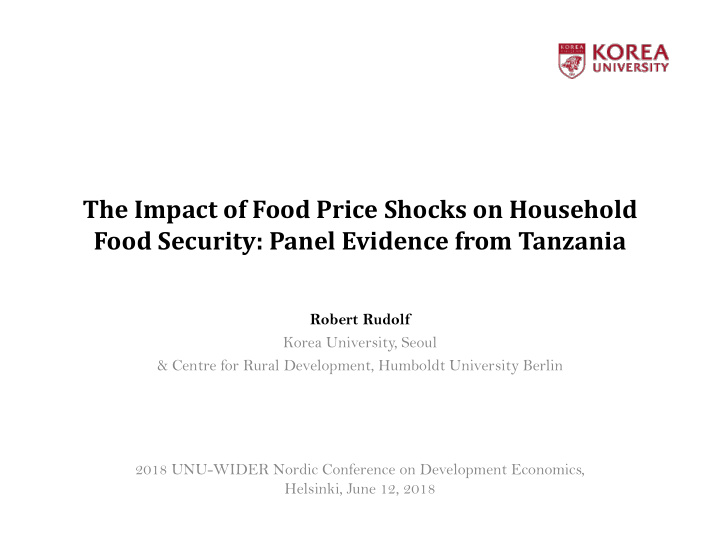



The Impact of Food Price Shocks on Household Food Security: Panel Evidence from Tanzania Robert Rudolf Korea University, Seoul & Centre for Rural Development, Humboldt University Berlin 2018 UNU-WIDER Nordic Conference on Development Economics, Helsinki, June 12, 2018
Introduction Horn of Africa 2011 famine left 10 million food insecure 2016 African food crisis - Massive droughts due to El Niño - An estimated 52 million were food insecure in East and Southern Africa
Introduction SDG target 2.c: “adopt measures […] in order to help limit extreme food price volatility.” Global volatilities dominate the international discourse However, a recent FAO report from East Africa shows that national and regional volatility components are the driving forces behind overall volatility in the region (MAFAP, 2013) - E.g. substantial deviations of East African maize prices from international reference prices between 2006 and 2012 - Causes: lack of integration with world markets; restrictive trade policies (on both import and export side)
Introduction
Introduction In theory, food prices can have mixed effects on poverty and hunger Most poor in developing countries are both consumers and producers of food Net-sellers (net-buyers) of crop A would be expected to gain (lose) from a price increase in A
Related literature Past research on the “Food price and food security nexus” usually draws on cross-sectional data (Ivanic and Martin, 2008; Brinkman et al., 2010; de Hoyos and Medvedev, 2011; Ecker and Qaim, 2011; Harttgen et al., 2016) - Ex-ante simulations - Demand elasticities derived from cross-sectional variation Papers usually find that higher prices of the main staple food negatively affect food security - Ecker and Qaim (2011) argue that consumer subsidies for maize might improve overall calorie and mineral consumption, but might worsen vitamin consumption in urban areas - Harttgen et al. (2016) show that the impact is particularly strong for poor net food buyers
Related literature - Anríquez et al. (2013): study of eight developing countries; food price spikes both reduce the calorie intake and worsen the distribution of food calories - Levin and Vimefall (2015): a 25% increase in maize prices in Kenya would negatively affect 80% of the population Akter and Basher (2014) use panel data from selected poor districts in rural Bangladesh - Not actual consumption, but self-reported food shortages - Find that soaring food prices between 2007 and 2009 unequivocally aggravated food security
Research objective & contribution Objective - Study the impact of food price shocks on household food security using a nationally representative dataset (T=3; N=2,689 hh) Contribution - First such study for an LDC using nationally representative panel data - Spatial setting and timing of study: one of the most populous SSA countries during a period of recurring food price crises - Various population groups studied (rural vs. urban, producers vs. non-producers of maize, landless vs. landowners)
Dataset Tanzania National Panel Survey (TZNPS) - Nationally representative longitudinal household surveys - Conducted every 2-years since 2008/09 - Initiated/Supported by World Bank (LSMS-ISA) - Broad information on agriculture, income, consumption, food intake, socio-economic background, village characteristics, geo variables, etc. - Low attrition: 95% of original sample re-interviewed in 3rd wave
Methodology Use of balanced panel (T=3; N=2,689 hh) Household fixed effects estimation Food security measure: Energy intake per day and per male adult-equivalent ( x it ) - TZNPS provides information on food consumption within and outside the household over the past week - Consumption of 59 individual food items aggregated into 11 major food groups k x kit
Methodology Food prices - Price data (kg prices, unit values) from household food purchases over the past week - Median prices ( p ) constructed by region ( r ), interview year ( y) , and quarter ( q ) - Regression-based imputation in some cases: not all 59 food prices observed in each of the 26 regions during each wave - Construction of Laspeyres-type price indexes ( I kit ): grouping 59 food items into 11 major food groups ( k ) - Food shares (weights of each food item in its food group) are average shares by region over all three waves
Methodology Marshallian demand elasticities - Own-price elasticity of demand - Cross-price elasticity of demand - Empirical implementation (FE estimation)
Methodology Impact of food price shocks on food security daily total energy intake per (male) adult equivalent:
Descriptive analysis
Descriptive analysis
Descriptive analysis
Descriptive analysis
Regression results
Regression results
Conclusions Between 2008/09 and 2012/13, food security slightly improved for urban Tanzanians, yet sharply deteriorated for rural dwellers Principal staple maize showed strongest price hikes among all major food items Main finding: Clear negative relationship between maize prices and individual energy intake Household demand for cereals more inelastic in rural areas rural households hit stronger by maize price hikes Most population groups negatively affected by maize price hikes; rural landless most vulnerable
Conclusions Past cross-section studies tended to overestimate price elasticities of food demand for developing country households - Dietary changes (substitution) happen much less than expected; probably due to tastes, fixed habits, traditions, cultural norms Governments should try to abstain from trade restrictions for major staples (particularly on the import side) to help smooth prices over time Governments might want to promote more dietary flexibility (alternative diets, cooking) in times of crisis
Thank you for your attention.
Recommend
More recommend